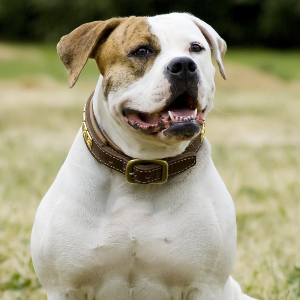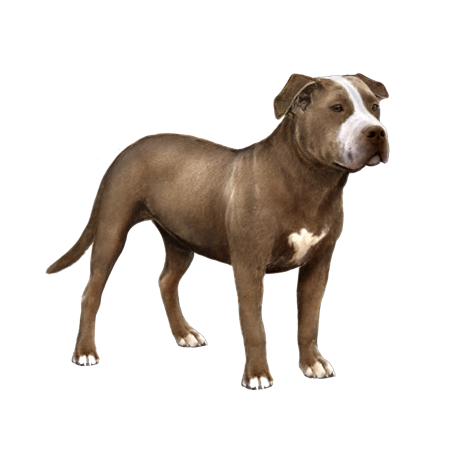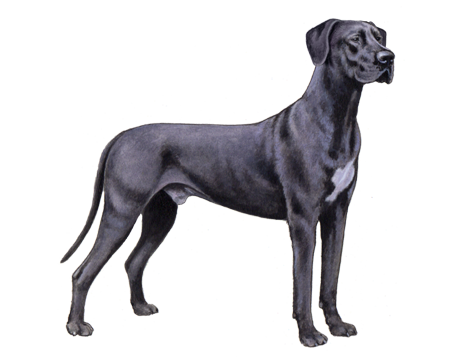
American Bulldog
American Bulldogs are powerful, alert, and self-confident dogs that demonstrate endurance and agility. Though they are known to be affectionate, loyal, and fun-loving companions that form stable bonds with their family members, American Bulldogs also have strong protective instincts.
Interested in discovering if your dog is an American Bulldog?
Check out Wisdom Panel's DNA tests.

American Bulldog Traits
General Appearance
Though they can vary in size and appearance depending on which line or strain they came from, American Bulldogs are typically stocky and well-built. The Johnson type American Bulldog is a large dog with a shorter muzzle, whereas the Scott type is smaller with a longer muzzle.
Coat and Coloring
The American Bulldog may be solid white or white with all shades of brindle (i.e., black with brown stripes), brown, red, fawn, or tan. The dog’s eyes are typically brown, which is the preferred color per the breed standard. Blue eyes can occur, but they are not common.
Distinctive Physical Traits
American Bulldogs have large heads, powerful jaws, and beefy builds that include a deep, broad chest, broad back, and muscular shoulders. The breed’s natural tail is thick at the base and tapers to a point.
American Bulldog Temperament
American Bulldogs often serve as guard, hunting, and working dogs. They require daily mental and physical activity to prevent hyperactivity and undesirable behaviors. American Bulldogs also need firm, consistent obedience training and socialization to be friendly toward strangers and easy to control in all situations. As such, this breed is best for experienced dog owners.
American Bulldogs can be wary of cats and other small pets and may react to strange dogs—especially those of the same sex. And there have been incidents of American Bulldog aggression toward other pets or people. But you can reduce the risk of such events through early socialization.


American Bulldog History
The American Bulldog is considered the closest surviving relative of the Old English Bulldog. Experts believe Bulldogs arrived in the United States as early as the 17th century, along with immigrant farmers and ranchers who put them to work as farm guardians (protecting livestock), stock dogs (herding livestock), and catch dogs (catching and holding mature livestock for slaughter).
By the late 1940s, the Bulldogs approached extinction. But thanks to breeding programs set up by John D. Johnson and Alan Scott, the American Bulldog survived. There are now two American Bulldog types named after the breeders: the Johnson, also known as the classic or bully type, and the Scott, which is sometimes called the standard or performance type.
In 1970, the National Kennel Club officially recognized and registered the American Bulldog breed. The American Bulldog Association started in 1989. And a year later, the United Kennel Club recognized the breed in the working class.
American Bulldog Care
Nutrition
American Bulldogs need a high-quality diet formulated for large dogs. To ensure slow and steady growth, they should eat large-breed puppy food for the first 14 months of life. And you should not feed them foods with added calcium until they are eating adult food.
Grooming
Grooming American Bulldogs is relatively easy. Their coats are fine and glossy, with moderate shedding. That means the breed needs only occasional brushing, and baths can typically wait until they get into something messy.
Exercise
The American Bulldog is an athletic breed. When young, the dogs shouldn’t engage in high-impact exercises. Otherwise, bone and joint damage are possible. Adult Bulldogs, on the other hand, can enjoy a range of invigorating activities—from jogs, hikes, and tug-a-war games to training exercises.
American Bulldogs often struggle when left alone for long periods. The boredom of solitude may drive them to develop a variety of behavior problems—such as chewing or digging. Meeting their needs for physical and mental stimulation can help prevent this.
Training
To help channel your American Bulldog’s energy, you should start socialization and puppy training classes early. It’s critical to establish rules and routines during puppyhood if you want your dog to behave once grown. And with this breed, you’ll need a firm but loving hand to set proper boundaries.
If exposed to good training practices, other dogs, and a variety of people, your American Bulldog will likely grow to be a well-mannered, manageable adult.

American Bulldog Genetic Health Conditions
-
Canine Multifocal Retinopathy 1
Canine Multifocal Retinopathy 1 (CMR1) is an eye disorder that can cause retinal decay which may impact vision, but very rarely results in blindness.
-
Hyperuricosuria
Hyperuricosuria (HUU) is a condition that predisposes affected dogs to the formation of urinary stones, such as kidney or bladder stones.
-
Ichthyosis (Discovered in the American Bulldog)
Ichthyosis is a skin condition causing generalized scaling of the skin and abdominal redness.
-
Nemaline Myopathy
Nemaline myopathy is a muscle disorder characterized by defects to muscle fibers causing weakness and tremors.
Knowing if your American Bulldog is a carrier or at-risk for these conditions can help you and your veterinarian plan for your pup’s lifelong care. With Wisdom Panel™ Premium, you can get results for over 200 genetic health tests.
Breed Group
Guard
Dogs of the Guard Group were bred to guard people and property. They are often quick to learn and these intelligent, capable animals make solid companions.
Resources
https://www.akc.org/dog-breeds/american-bulldog/
https://vcahospitals.com/know-your-pet/dog-breeds/bulldog
Reviewed July 26, 2020 by Cindy Elston, DVM, MPH





































